Evidence Law Report: BSBLEG417 - Applying Evidence Law Principles
VerifiedAdded on 2022/11/29
|9
|1778
|341
Report
AI Summary
This report provides a comprehensive analysis of two simulated evidence law matters. It begins with an introduction outlining the scope of the analysis, which focuses on identifying key issues related to the evidence presented, submissions, and potential objections. The report evaluates the relevance and admissibility of evidence, considering the consequences of irrelevant or inadmissible evidence. Matter 1 examines a case involving a murder, evaluating evidence such as prior verbal assaults, the opinion of a farmer on rifle function, and hearsay statements. Matter 2 assesses a case of armed robbery, addressing the admissibility of witness testimony, similar crimes, and the application of evidence rules. The report references relevant sections of the Evidence Act 1995 (NSW) and case law to support its arguments, concluding with a summary of the admissibility and relevance of the presented evidence in each matter.
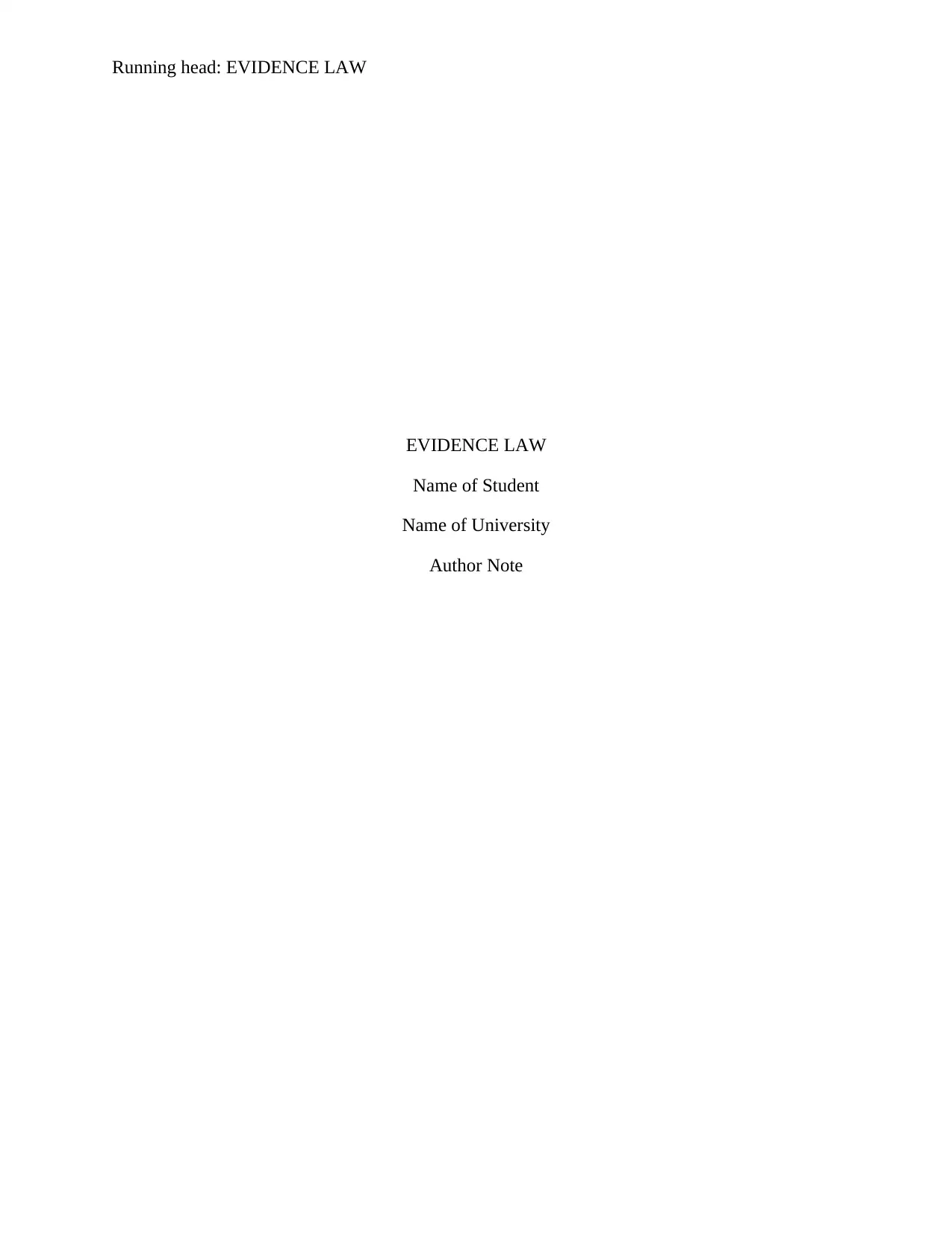
Running head: EVIDENCE LAW
EVIDENCE LAW
Name of Student
Name of University
Author Note
EVIDENCE LAW
Name of Student
Name of University
Author Note
Paraphrase This Document
Need a fresh take? Get an instant paraphrase of this document with our AI Paraphraser
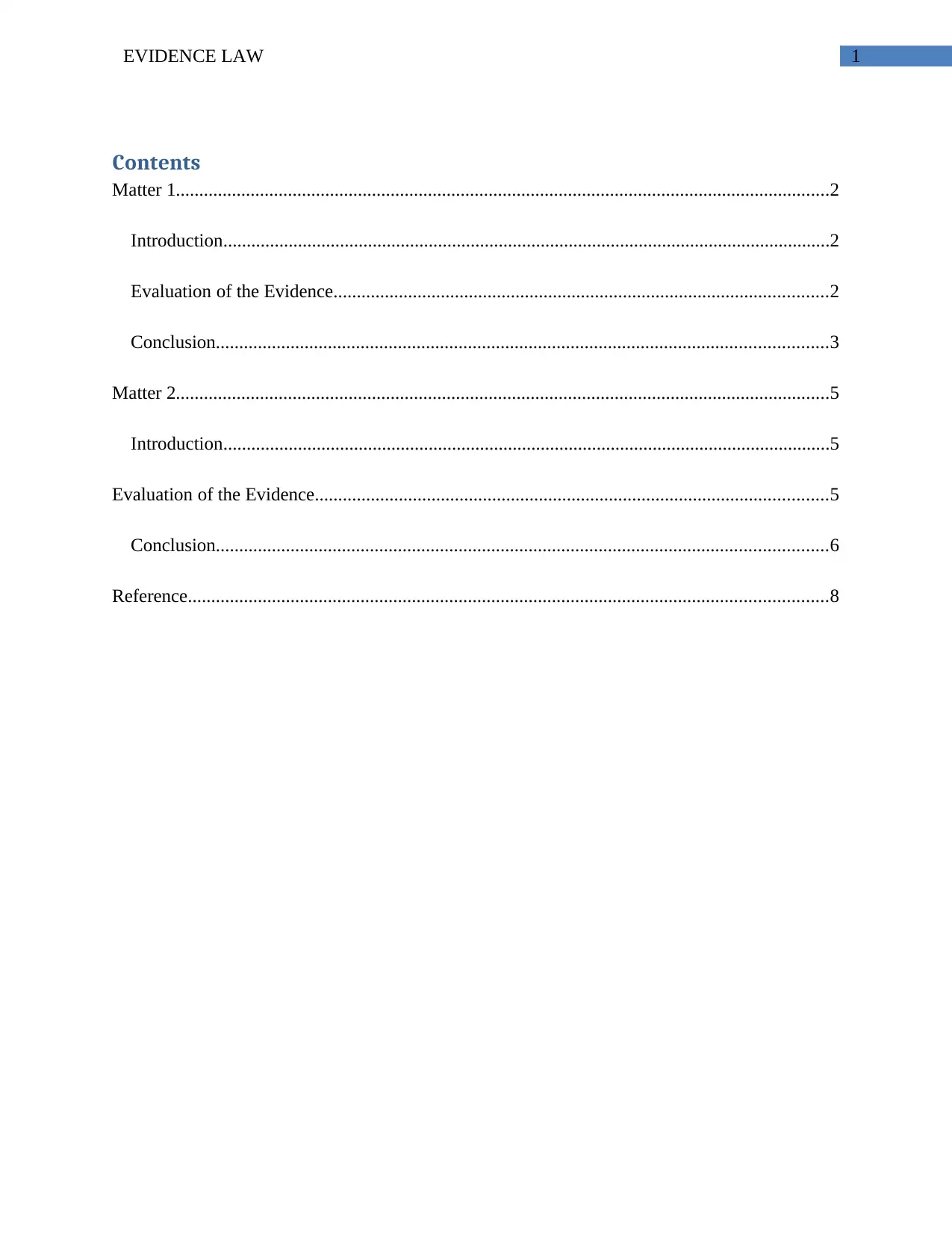
1EVIDENCE LAW
Contents
Matter 1............................................................................................................................................2
Introduction..................................................................................................................................2
Evaluation of the Evidence..........................................................................................................2
Conclusion...................................................................................................................................3
Matter 2............................................................................................................................................5
Introduction..................................................................................................................................5
Evaluation of the Evidence..............................................................................................................5
Conclusion...................................................................................................................................6
Reference.........................................................................................................................................8
Contents
Matter 1............................................................................................................................................2
Introduction..................................................................................................................................2
Evaluation of the Evidence..........................................................................................................2
Conclusion...................................................................................................................................3
Matter 2............................................................................................................................................5
Introduction..................................................................................................................................5
Evaluation of the Evidence..............................................................................................................5
Conclusion...................................................................................................................................6
Reference.........................................................................................................................................8
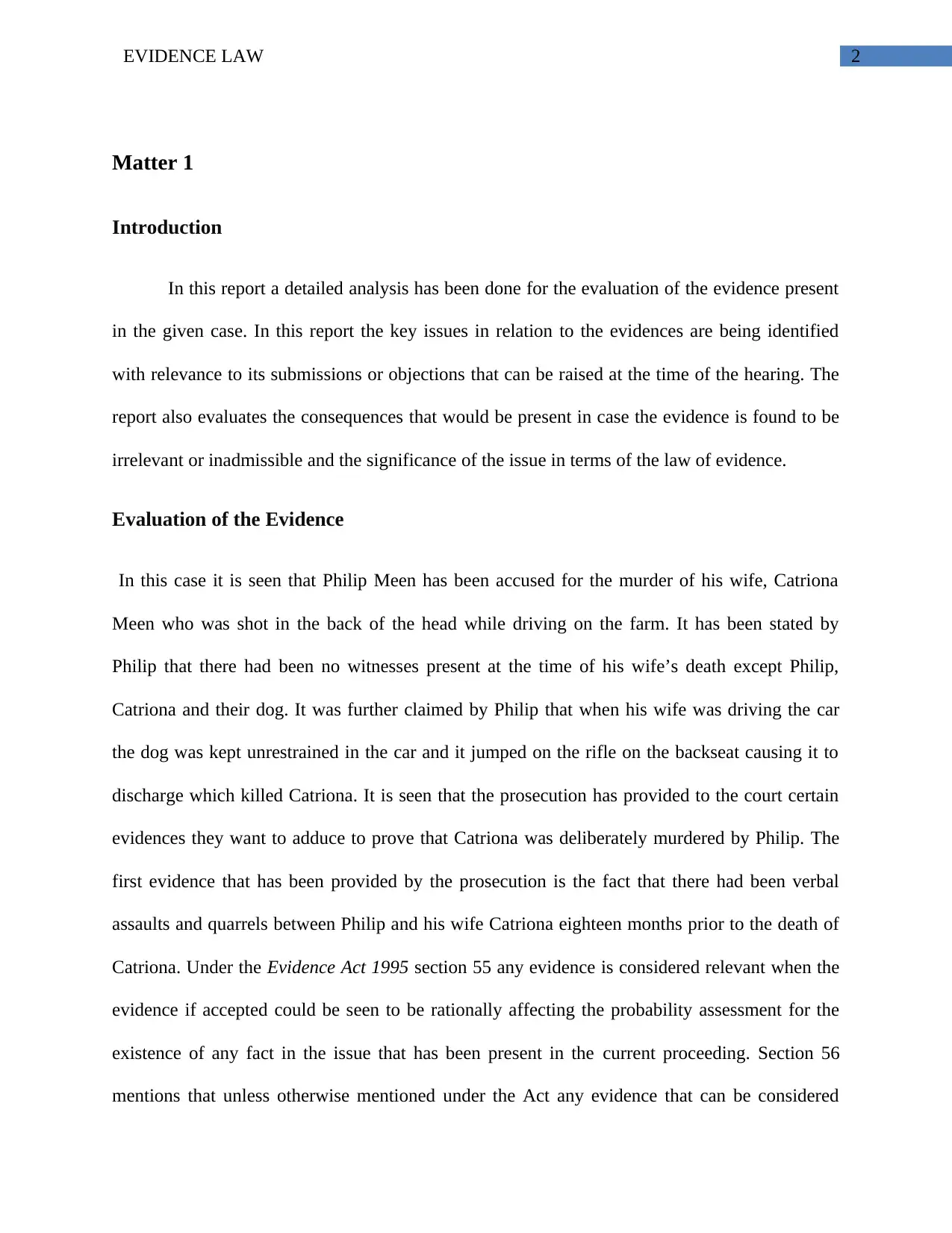
2EVIDENCE LAW
Matter 1
Introduction
In this report a detailed analysis has been done for the evaluation of the evidence present
in the given case. In this report the key issues in relation to the evidences are being identified
with relevance to its submissions or objections that can be raised at the time of the hearing. The
report also evaluates the consequences that would be present in case the evidence is found to be
irrelevant or inadmissible and the significance of the issue in terms of the law of evidence.
Evaluation of the Evidence
In this case it is seen that Philip Meen has been accused for the murder of his wife, Catriona
Meen who was shot in the back of the head while driving on the farm. It has been stated by
Philip that there had been no witnesses present at the time of his wife’s death except Philip,
Catriona and their dog. It was further claimed by Philip that when his wife was driving the car
the dog was kept unrestrained in the car and it jumped on the rifle on the backseat causing it to
discharge which killed Catriona. It is seen that the prosecution has provided to the court certain
evidences they want to adduce to prove that Catriona was deliberately murdered by Philip. The
first evidence that has been provided by the prosecution is the fact that there had been verbal
assaults and quarrels between Philip and his wife Catriona eighteen months prior to the death of
Catriona. Under the Evidence Act 1995 section 55 any evidence is considered relevant when the
evidence if accepted could be seen to be rationally affecting the probability assessment for the
existence of any fact in the issue that has been present in the current proceeding. Section 56
mentions that unless otherwise mentioned under the Act any evidence that can be considered
Matter 1
Introduction
In this report a detailed analysis has been done for the evaluation of the evidence present
in the given case. In this report the key issues in relation to the evidences are being identified
with relevance to its submissions or objections that can be raised at the time of the hearing. The
report also evaluates the consequences that would be present in case the evidence is found to be
irrelevant or inadmissible and the significance of the issue in terms of the law of evidence.
Evaluation of the Evidence
In this case it is seen that Philip Meen has been accused for the murder of his wife, Catriona
Meen who was shot in the back of the head while driving on the farm. It has been stated by
Philip that there had been no witnesses present at the time of his wife’s death except Philip,
Catriona and their dog. It was further claimed by Philip that when his wife was driving the car
the dog was kept unrestrained in the car and it jumped on the rifle on the backseat causing it to
discharge which killed Catriona. It is seen that the prosecution has provided to the court certain
evidences they want to adduce to prove that Catriona was deliberately murdered by Philip. The
first evidence that has been provided by the prosecution is the fact that there had been verbal
assaults and quarrels between Philip and his wife Catriona eighteen months prior to the death of
Catriona. Under the Evidence Act 1995 section 55 any evidence is considered relevant when the
evidence if accepted could be seen to be rationally affecting the probability assessment for the
existence of any fact in the issue that has been present in the current proceeding. Section 56
mentions that unless otherwise mentioned under the Act any evidence that can be considered
⊘ This is a preview!⊘
Do you want full access?
Subscribe today to unlock all pages.

Trusted by 1+ million students worldwide
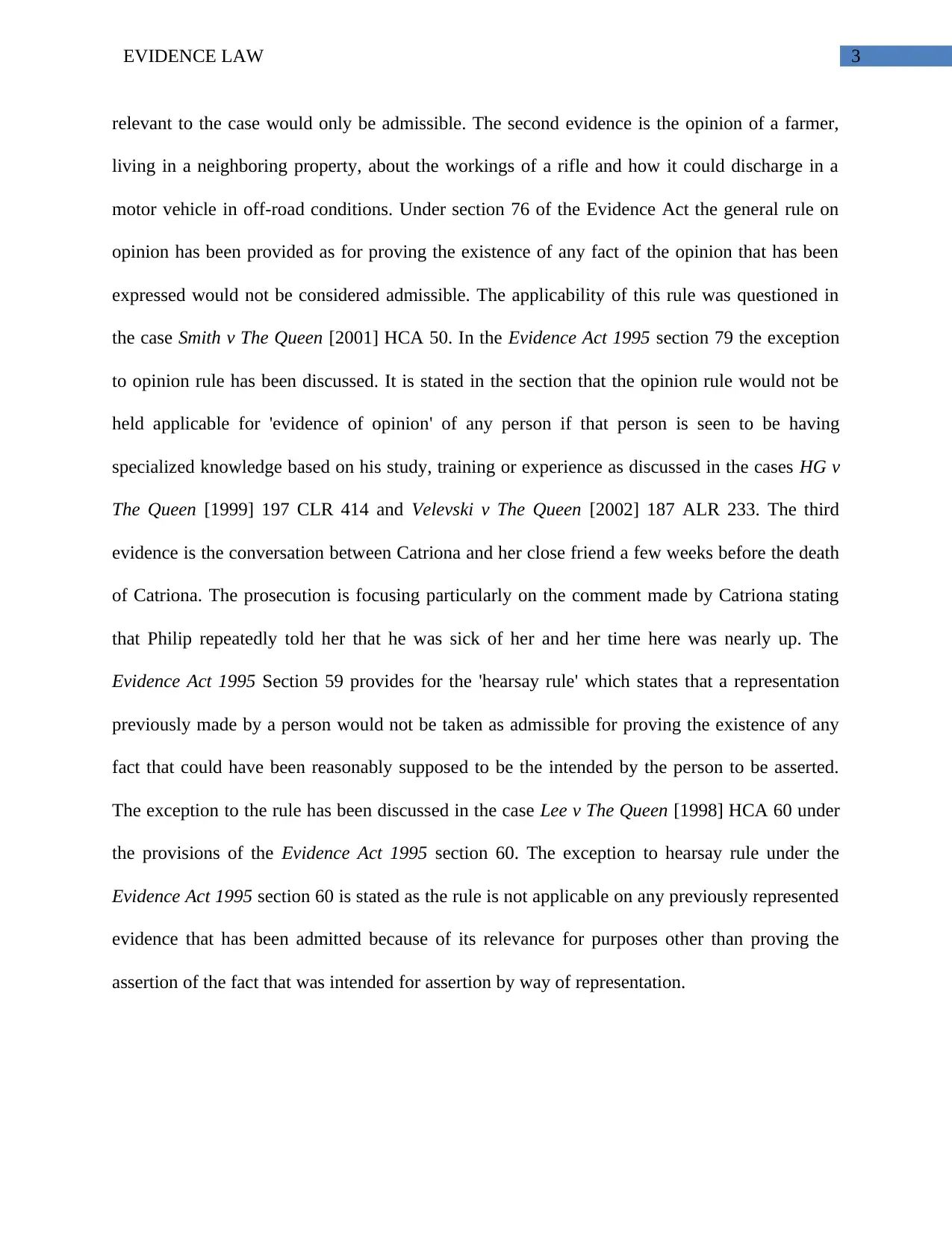
3EVIDENCE LAW
relevant to the case would only be admissible. The second evidence is the opinion of a farmer,
living in a neighboring property, about the workings of a rifle and how it could discharge in a
motor vehicle in off-road conditions. Under section 76 of the Evidence Act the general rule on
opinion has been provided as for proving the existence of any fact of the opinion that has been
expressed would not be considered admissible. The applicability of this rule was questioned in
the case Smith v The Queen [2001] HCA 50. In the Evidence Act 1995 section 79 the exception
to opinion rule has been discussed. It is stated in the section that the opinion rule would not be
held applicable for 'evidence of opinion' of any person if that person is seen to be having
specialized knowledge based on his study, training or experience as discussed in the cases HG v
The Queen [1999] 197 CLR 414 and Velevski v The Queen [2002] 187 ALR 233. The third
evidence is the conversation between Catriona and her close friend a few weeks before the death
of Catriona. The prosecution is focusing particularly on the comment made by Catriona stating
that Philip repeatedly told her that he was sick of her and her time here was nearly up. The
Evidence Act 1995 Section 59 provides for the 'hearsay rule' which states that a representation
previously made by a person would not be taken as admissible for proving the existence of any
fact that could have been reasonably supposed to be the intended by the person to be asserted.
The exception to the rule has been discussed in the case Lee v The Queen [1998] HCA 60 under
the provisions of the Evidence Act 1995 section 60. The exception to hearsay rule under the
Evidence Act 1995 section 60 is stated as the rule is not applicable on any previously represented
evidence that has been admitted because of its relevance for purposes other than proving the
assertion of the fact that was intended for assertion by way of representation.
relevant to the case would only be admissible. The second evidence is the opinion of a farmer,
living in a neighboring property, about the workings of a rifle and how it could discharge in a
motor vehicle in off-road conditions. Under section 76 of the Evidence Act the general rule on
opinion has been provided as for proving the existence of any fact of the opinion that has been
expressed would not be considered admissible. The applicability of this rule was questioned in
the case Smith v The Queen [2001] HCA 50. In the Evidence Act 1995 section 79 the exception
to opinion rule has been discussed. It is stated in the section that the opinion rule would not be
held applicable for 'evidence of opinion' of any person if that person is seen to be having
specialized knowledge based on his study, training or experience as discussed in the cases HG v
The Queen [1999] 197 CLR 414 and Velevski v The Queen [2002] 187 ALR 233. The third
evidence is the conversation between Catriona and her close friend a few weeks before the death
of Catriona. The prosecution is focusing particularly on the comment made by Catriona stating
that Philip repeatedly told her that he was sick of her and her time here was nearly up. The
Evidence Act 1995 Section 59 provides for the 'hearsay rule' which states that a representation
previously made by a person would not be taken as admissible for proving the existence of any
fact that could have been reasonably supposed to be the intended by the person to be asserted.
The exception to the rule has been discussed in the case Lee v The Queen [1998] HCA 60 under
the provisions of the Evidence Act 1995 section 60. The exception to hearsay rule under the
Evidence Act 1995 section 60 is stated as the rule is not applicable on any previously represented
evidence that has been admitted because of its relevance for purposes other than proving the
assertion of the fact that was intended for assertion by way of representation.
Paraphrase This Document
Need a fresh take? Get an instant paraphrase of this document with our AI Paraphraser
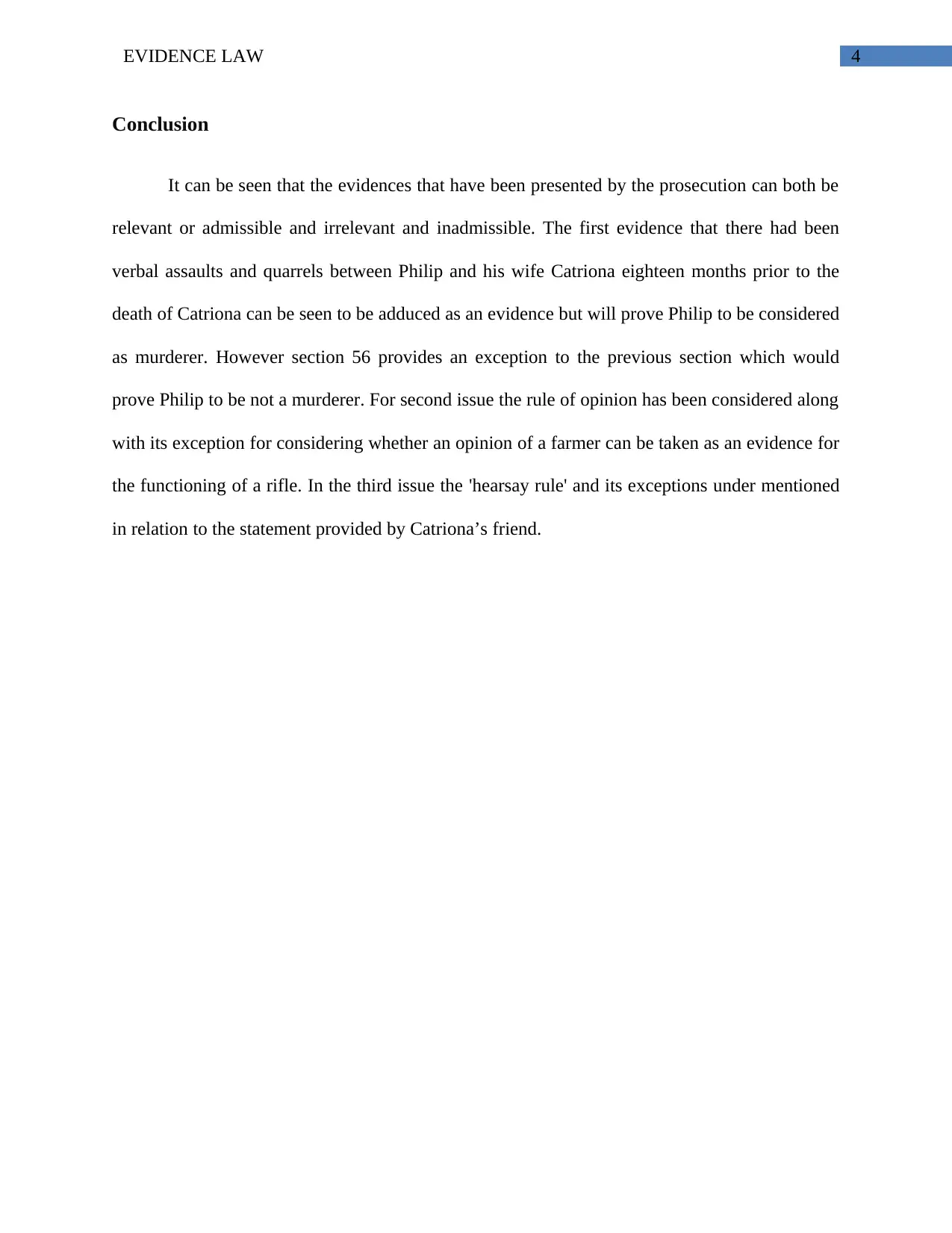
4EVIDENCE LAW
Conclusion
It can be seen that the evidences that have been presented by the prosecution can both be
relevant or admissible and irrelevant and inadmissible. The first evidence that there had been
verbal assaults and quarrels between Philip and his wife Catriona eighteen months prior to the
death of Catriona can be seen to be adduced as an evidence but will prove Philip to be considered
as murderer. However section 56 provides an exception to the previous section which would
prove Philip to be not a murderer. For second issue the rule of opinion has been considered along
with its exception for considering whether an opinion of a farmer can be taken as an evidence for
the functioning of a rifle. In the third issue the 'hearsay rule' and its exceptions under mentioned
in relation to the statement provided by Catriona’s friend.
Conclusion
It can be seen that the evidences that have been presented by the prosecution can both be
relevant or admissible and irrelevant and inadmissible. The first evidence that there had been
verbal assaults and quarrels between Philip and his wife Catriona eighteen months prior to the
death of Catriona can be seen to be adduced as an evidence but will prove Philip to be considered
as murderer. However section 56 provides an exception to the previous section which would
prove Philip to be not a murderer. For second issue the rule of opinion has been considered along
with its exception for considering whether an opinion of a farmer can be taken as an evidence for
the functioning of a rifle. In the third issue the 'hearsay rule' and its exceptions under mentioned
in relation to the statement provided by Catriona’s friend.
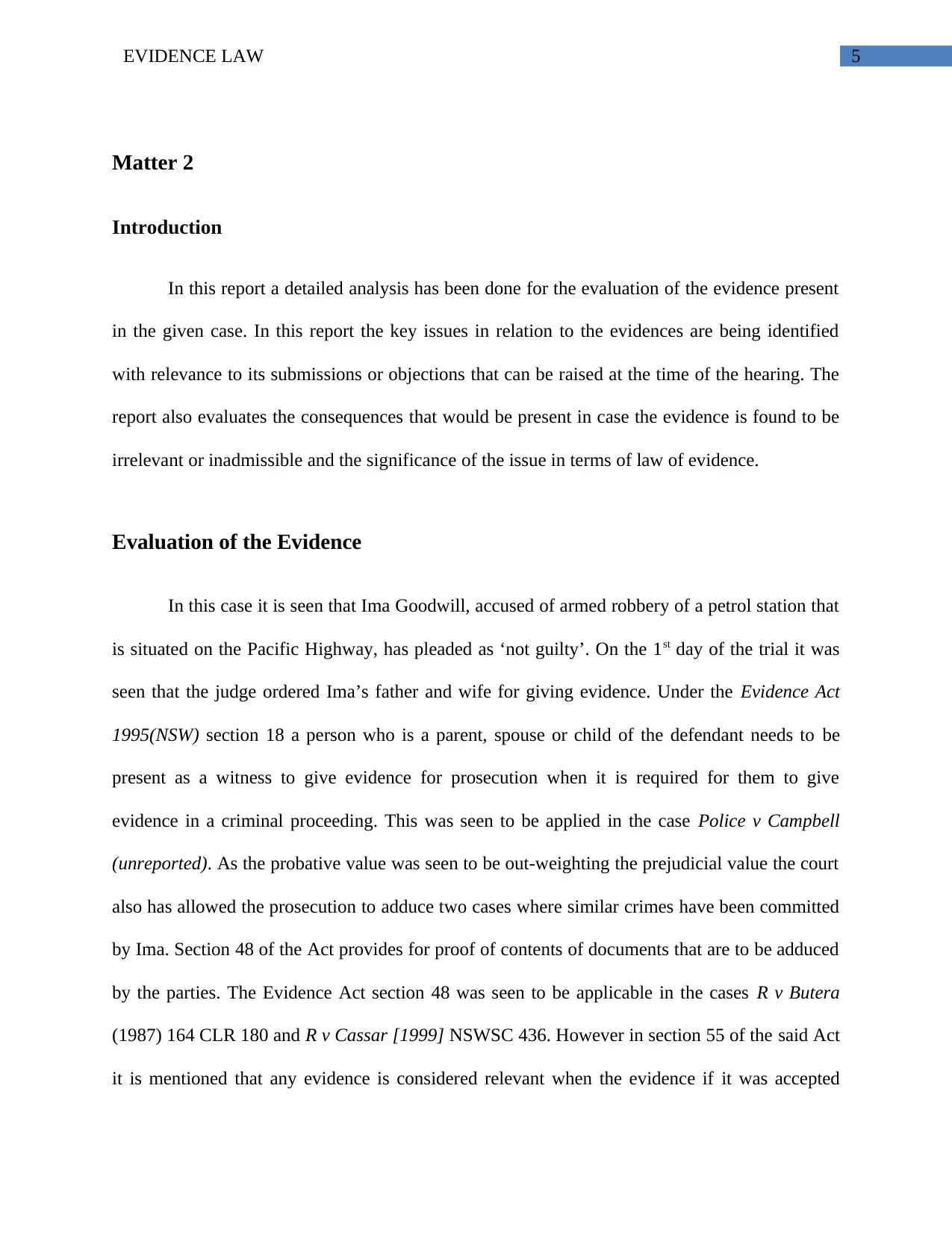
5EVIDENCE LAW
Matter 2
Introduction
In this report a detailed analysis has been done for the evaluation of the evidence present
in the given case. In this report the key issues in relation to the evidences are being identified
with relevance to its submissions or objections that can be raised at the time of the hearing. The
report also evaluates the consequences that would be present in case the evidence is found to be
irrelevant or inadmissible and the significance of the issue in terms of law of evidence.
Evaluation of the Evidence
In this case it is seen that Ima Goodwill, accused of armed robbery of a petrol station that
is situated on the Pacific Highway, has pleaded as ‘not guilty’. On the 1st day of the trial it was
seen that the judge ordered Ima’s father and wife for giving evidence. Under the Evidence Act
1995(NSW) section 18 a person who is a parent, spouse or child of the defendant needs to be
present as a witness to give evidence for prosecution when it is required for them to give
evidence in a criminal proceeding. This was seen to be applied in the case Police v Campbell
(unreported). As the probative value was seen to be out-weighting the prejudicial value the court
also has allowed the prosecution to adduce two cases where similar crimes have been committed
by Ima. Section 48 of the Act provides for proof of contents of documents that are to be adduced
by the parties. The Evidence Act section 48 was seen to be applicable in the cases R v Butera
(1987) 164 CLR 180 and R v Cassar [1999] NSWSC 436. However in section 55 of the said Act
it is mentioned that any evidence is considered relevant when the evidence if it was accepted
Matter 2
Introduction
In this report a detailed analysis has been done for the evaluation of the evidence present
in the given case. In this report the key issues in relation to the evidences are being identified
with relevance to its submissions or objections that can be raised at the time of the hearing. The
report also evaluates the consequences that would be present in case the evidence is found to be
irrelevant or inadmissible and the significance of the issue in terms of law of evidence.
Evaluation of the Evidence
In this case it is seen that Ima Goodwill, accused of armed robbery of a petrol station that
is situated on the Pacific Highway, has pleaded as ‘not guilty’. On the 1st day of the trial it was
seen that the judge ordered Ima’s father and wife for giving evidence. Under the Evidence Act
1995(NSW) section 18 a person who is a parent, spouse or child of the defendant needs to be
present as a witness to give evidence for prosecution when it is required for them to give
evidence in a criminal proceeding. This was seen to be applied in the case Police v Campbell
(unreported). As the probative value was seen to be out-weighting the prejudicial value the court
also has allowed the prosecution to adduce two cases where similar crimes have been committed
by Ima. Section 48 of the Act provides for proof of contents of documents that are to be adduced
by the parties. The Evidence Act section 48 was seen to be applicable in the cases R v Butera
(1987) 164 CLR 180 and R v Cassar [1999] NSWSC 436. However in section 55 of the said Act
it is mentioned that any evidence is considered relevant when the evidence if it was accepted
⊘ This is a preview!⊘
Do you want full access?
Subscribe today to unlock all pages.

Trusted by 1+ million students worldwide
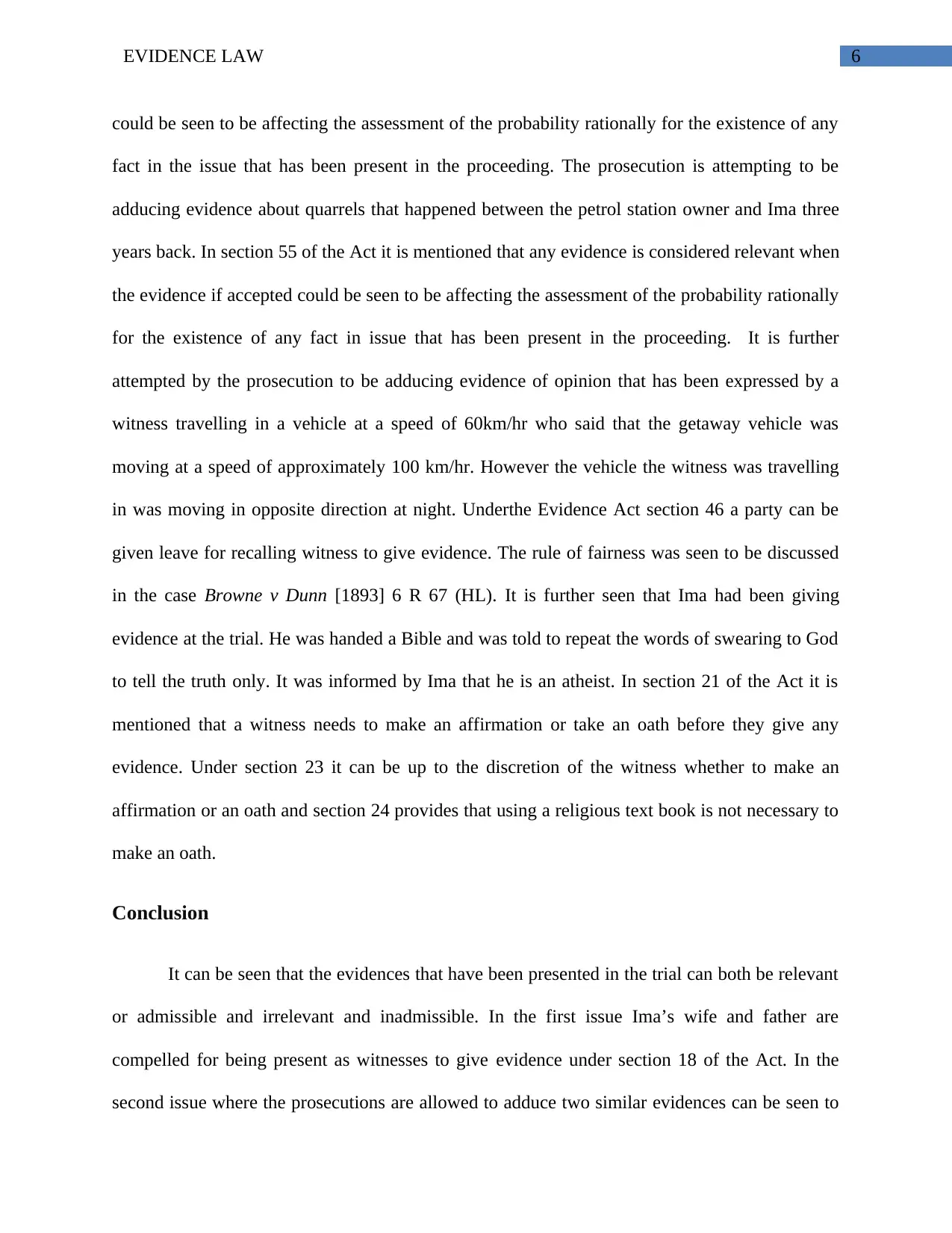
6EVIDENCE LAW
could be seen to be affecting the assessment of the probability rationally for the existence of any
fact in the issue that has been present in the proceeding. The prosecution is attempting to be
adducing evidence about quarrels that happened between the petrol station owner and Ima three
years back. In section 55 of the Act it is mentioned that any evidence is considered relevant when
the evidence if accepted could be seen to be affecting the assessment of the probability rationally
for the existence of any fact in issue that has been present in the proceeding. It is further
attempted by the prosecution to be adducing evidence of opinion that has been expressed by a
witness travelling in a vehicle at a speed of 60km/hr who said that the getaway vehicle was
moving at a speed of approximately 100 km/hr. However the vehicle the witness was travelling
in was moving in opposite direction at night. Underthe Evidence Act section 46 a party can be
given leave for recalling witness to give evidence. The rule of fairness was seen to be discussed
in the case Browne v Dunn [1893] 6 R 67 (HL). It is further seen that Ima had been giving
evidence at the trial. He was handed a Bible and was told to repeat the words of swearing to God
to tell the truth only. It was informed by Ima that he is an atheist. In section 21 of the Act it is
mentioned that a witness needs to make an affirmation or take an oath before they give any
evidence. Under section 23 it can be up to the discretion of the witness whether to make an
affirmation or an oath and section 24 provides that using a religious text book is not necessary to
make an oath.
Conclusion
It can be seen that the evidences that have been presented in the trial can both be relevant
or admissible and irrelevant and inadmissible. In the first issue Ima’s wife and father are
compelled for being present as witnesses to give evidence under section 18 of the Act. In the
second issue where the prosecutions are allowed to adduce two similar evidences can be seen to
could be seen to be affecting the assessment of the probability rationally for the existence of any
fact in the issue that has been present in the proceeding. The prosecution is attempting to be
adducing evidence about quarrels that happened between the petrol station owner and Ima three
years back. In section 55 of the Act it is mentioned that any evidence is considered relevant when
the evidence if accepted could be seen to be affecting the assessment of the probability rationally
for the existence of any fact in issue that has been present in the proceeding. It is further
attempted by the prosecution to be adducing evidence of opinion that has been expressed by a
witness travelling in a vehicle at a speed of 60km/hr who said that the getaway vehicle was
moving at a speed of approximately 100 km/hr. However the vehicle the witness was travelling
in was moving in opposite direction at night. Underthe Evidence Act section 46 a party can be
given leave for recalling witness to give evidence. The rule of fairness was seen to be discussed
in the case Browne v Dunn [1893] 6 R 67 (HL). It is further seen that Ima had been giving
evidence at the trial. He was handed a Bible and was told to repeat the words of swearing to God
to tell the truth only. It was informed by Ima that he is an atheist. In section 21 of the Act it is
mentioned that a witness needs to make an affirmation or take an oath before they give any
evidence. Under section 23 it can be up to the discretion of the witness whether to make an
affirmation or an oath and section 24 provides that using a religious text book is not necessary to
make an oath.
Conclusion
It can be seen that the evidences that have been presented in the trial can both be relevant
or admissible and irrelevant and inadmissible. In the first issue Ima’s wife and father are
compelled for being present as witnesses to give evidence under section 18 of the Act. In the
second issue where the prosecutions are allowed to adduce two similar evidences can be seen to
Paraphrase This Document
Need a fresh take? Get an instant paraphrase of this document with our AI Paraphraser
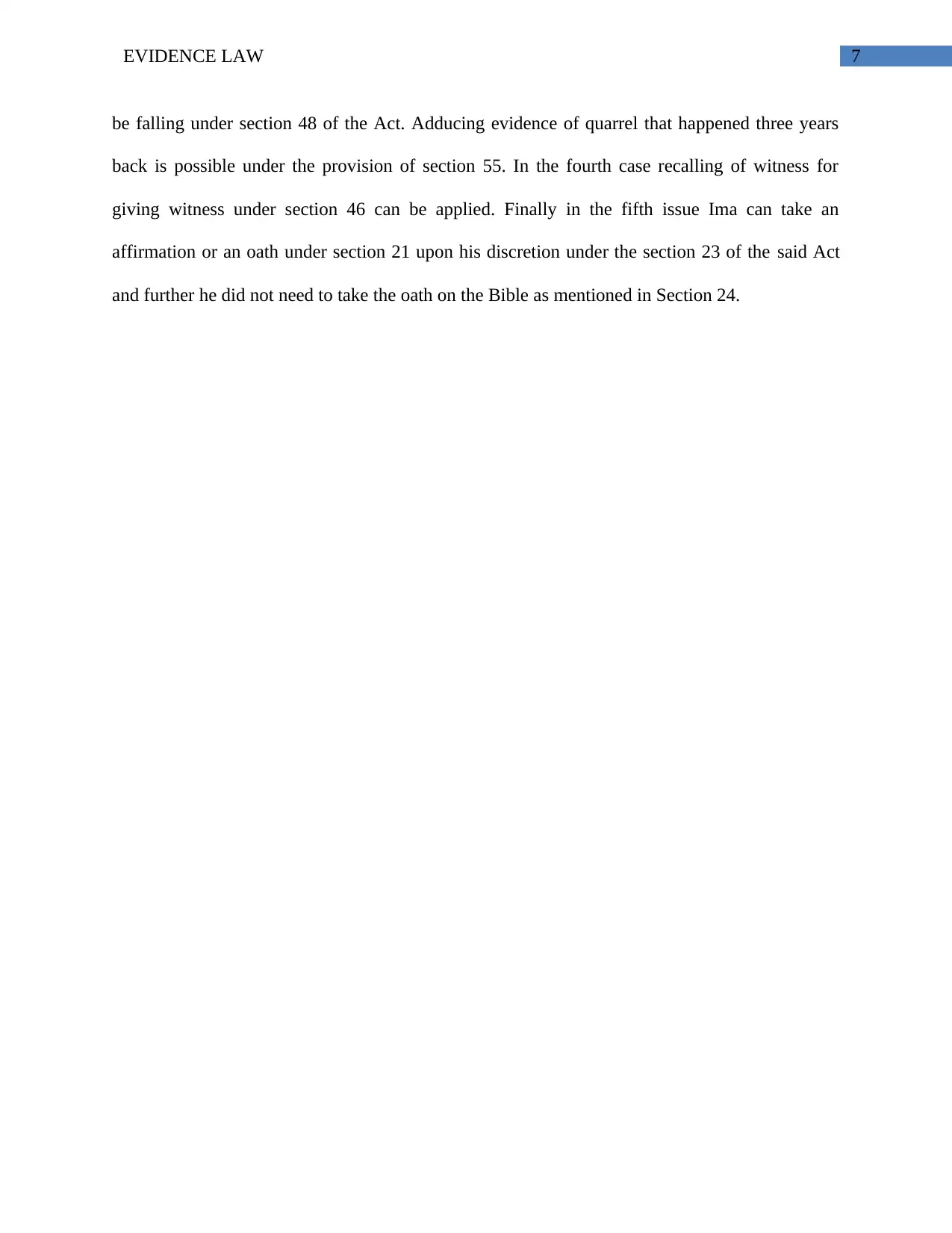
7EVIDENCE LAW
be falling under section 48 of the Act. Adducing evidence of quarrel that happened three years
back is possible under the provision of section 55. In the fourth case recalling of witness for
giving witness under section 46 can be applied. Finally in the fifth issue Ima can take an
affirmation or an oath under section 21 upon his discretion under the section 23 of the said Act
and further he did not need to take the oath on the Bible as mentioned in Section 24.
be falling under section 48 of the Act. Adducing evidence of quarrel that happened three years
back is possible under the provision of section 55. In the fourth case recalling of witness for
giving witness under section 46 can be applied. Finally in the fifth issue Ima can take an
affirmation or an oath under section 21 upon his discretion under the section 23 of the said Act
and further he did not need to take the oath on the Bible as mentioned in Section 24.
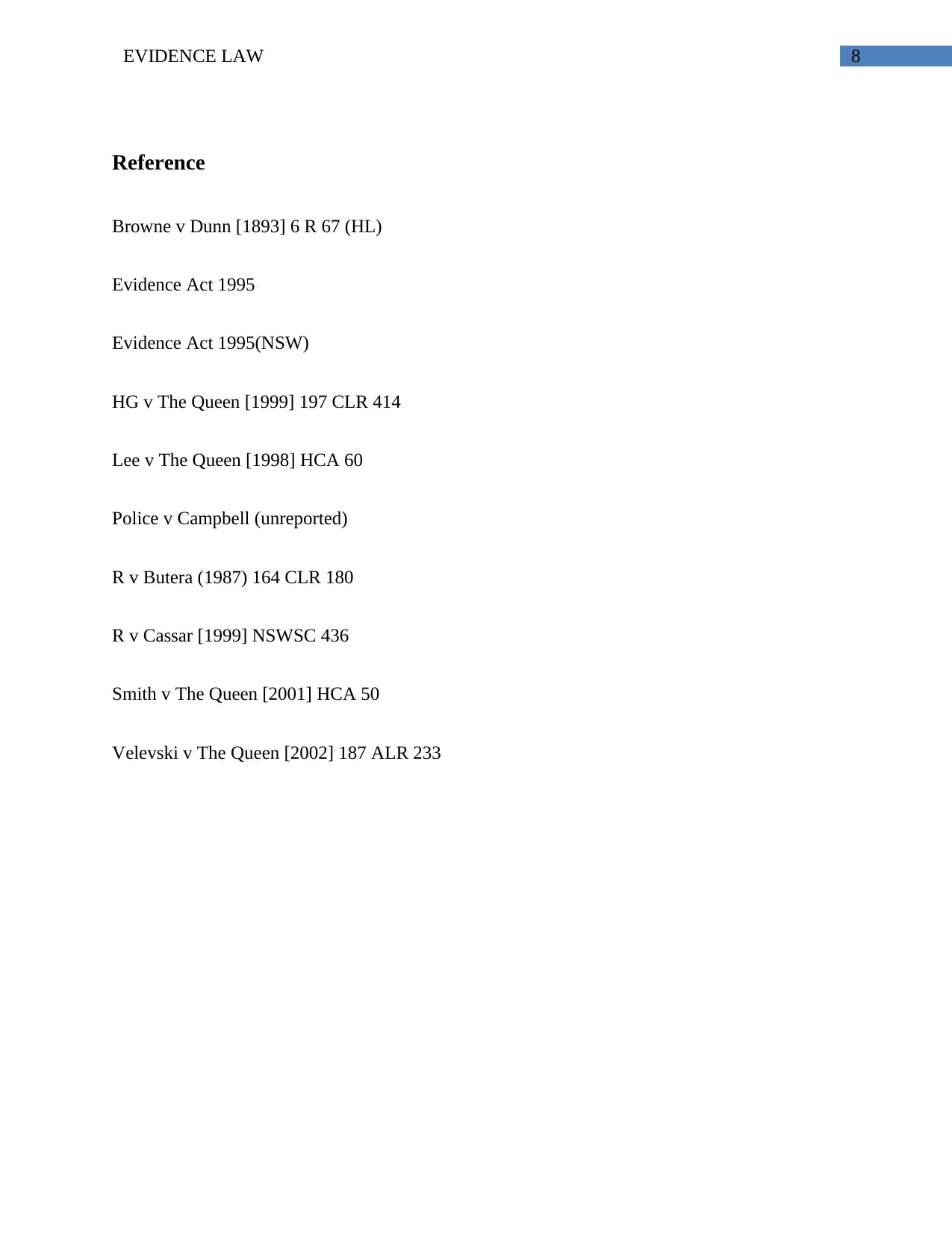
8EVIDENCE LAW
Reference
Browne v Dunn [1893] 6 R 67 (HL)
Evidence Act 1995
Evidence Act 1995(NSW)
HG v The Queen [1999] 197 CLR 414
Lee v The Queen [1998] HCA 60
Police v Campbell (unreported)
R v Butera (1987) 164 CLR 180
R v Cassar [1999] NSWSC 436
Smith v The Queen [2001] HCA 50
Velevski v The Queen [2002] 187 ALR 233
Reference
Browne v Dunn [1893] 6 R 67 (HL)
Evidence Act 1995
Evidence Act 1995(NSW)
HG v The Queen [1999] 197 CLR 414
Lee v The Queen [1998] HCA 60
Police v Campbell (unreported)
R v Butera (1987) 164 CLR 180
R v Cassar [1999] NSWSC 436
Smith v The Queen [2001] HCA 50
Velevski v The Queen [2002] 187 ALR 233
⊘ This is a preview!⊘
Do you want full access?
Subscribe today to unlock all pages.

Trusted by 1+ million students worldwide
1 out of 9
Related Documents
Your All-in-One AI-Powered Toolkit for Academic Success.
+13062052269
info@desklib.com
Available 24*7 on WhatsApp / Email
![[object Object]](/_next/static/media/star-bottom.7253800d.svg)
Unlock your academic potential
Copyright © 2020–2025 A2Z Services. All Rights Reserved. Developed and managed by ZUCOL.





